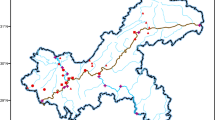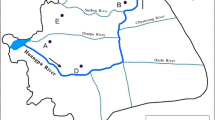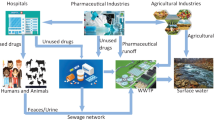Abstract
The study presented the occurrence of antibiotics in 16 different hospital effluents, the removal of antibiotics in urban wastewater treatment plant (WWTP), and the potential ecotoxicological risks of the effluent discharge on the aquatic ecosystem. The total concentration of antibiotics in hospital effluents was ranged from 21.2 ± 0.13 to 4886 ± 3.80 ng/L in summer and from 497 ± 3.66 to 322,735 ± 4.58 ng/L in winter. Azithromycin, clarithromycin, and ciprofloxacin were detected the highest concentrations among the investigated antibiotics. The total antibiotic load to the influent of the WWTP from hospitals was 3.46 g/day in summer and 303.2 g/day in winter. The total antibiotic contribution of hospitals to the influent of the WWTP was determined as 13% in summer and 28% in winter. The remaining 87% in summer and 72% in winter stems from the households. The total antibiotic removal by conventional physical and biological treatment processes was determined as 79% in summer, whereas it decreased to 36% in winter. When the environmental risk assessment was performed, azithromycin and clarithromycin in the effluent from the treatment plant in winter posed a high risk (RQ > 10) for the aquatic organisms (algae and fish) in the receiving environment. According to these results, the removal efficiency of antibiotics at the WWTP is inadequate and plant should be improved to remove antibiotics by advanced treatment processes.

Similar content being viewed by others
References
Alygizakis NA, Gago-Ferrero P, Borova VL, Pavlidou A, Hatzianestis I, Thomaidis NS (2016) Occurrence and spatial distribution of 158 pharmaceuticals, drugs of abuse and related metabolites in offshore seawater. Sci Total Environ 541:1097–1105
Andersson DI, Hughes D (2014) Microbiological effects of sublethal levels of antibiotics. Nat Rev Microbiol 12:465–478
APHA (1992) Standard methods for the examination of water and waste water, 17th edn. American Public Health Association, Washington, DC
Ashfaq M, Noor N, Rehman MSU, Sun Q, Mustafa G, Nazar MF, Yu CP (2017) Determination of commonly used pharmaceuticals in hospital waste of Pakistan and evaluation of their ecological risk assessment. Clean Soil Air Water 45:1–10
Baquero F, Coque TM (2014) Widening the spaces of selection: evolution along sublethal antimicrobial gradients. MBio 5:1–3
Behera SK, Kim HW, Oh JE, Park HS (2011) Occurrence and removal of antibiotics, hormones and several other pharmaceuticals in wastewater treatment plants of the largest industrial city of Korea. Sci Total Environ 409:4351–4360
Blair B, Nikolaus A, Hedman C, Klaper R, Grundl T (2015) Evaluating the degradation, sorption, and negative mass balances of pharmaceuticals and personal care products during wastewater treatment. Chemosphere 134:395–401
Brown K, Kulis J, Thomson B, Chapman T, Mavhinney D (2006) Occurrence of antibiotics in hospital, residental and dairy effluent, municipal wastewater and the Rio Grande in New Mexico. Sci Total Environ 366:772–783
Carraro E, Bonetta S, Bertino C, Lorenzi E, Bonetta S, Gilli G (2016) Hospital effluents management: chemical, physical, microbiological risks and legislation in different countries. J Environ Manag 168:185–199
Chagas TP, Seki LM, Cury JC, Oliveira JA, Dávila AM, Silva DM, Asensi MD (2011) Multiresistance, beta-lactamase-encoding genes and bacterial diversity in hospital wastewater in Rio de Janeiro, Brazil. J Appl Microbiol 111:572–581
Chang X, Meyer M, Liu X, Zhao Q, Chen H, Chen J, Qui Z, Yang L, Cao J, Shu W (2010) Determination of antibiotics in sewage from hospitals, nursery and slaughter house, wastewater treatment plant and source water in changing region of Three Gorge Reservoir in China. Environ Pollut 158:1444–1450
Collado N, Rodriguez-Mozaz S, Gros M, Rubirola A, Barceló D, Comas J, Rodriguez-Roda I, Buttiglieri G (2014) Pharmaceuticals occurrence in a WWTP with significant industrial contribution and its input into the river system. Environ Pollut 185:202–212
Commission of the European Communities (2003) Technical guidance document in support of commission directive 93/67/ EEC on risk assessment for new notified substances. Part II, Environmental Risk Assessment. Office for official publication of the European Communities, Luxembourg
Cunningham VL, Buzby M, Huthcinson T, Mastrocco F, Parke N, Roden N (2006) Effects of human pharmaceuticals on aquatic life: next steps. Environ Sci Technol 40:3456–3462
Deblonde T, Hartemann P (2013) Environmental impact of medical prescriptions: assessing the risks and hazards of persistence, bioaccumulation and toxicity of pharmaceuticals. Public Health 127:312–317
Dinh QT, Moreau-Guigon E, Labadie P, Alliot F, Teil MJ, Blanchard M, Eurin J, Chevreuil M (2017) Fate of antibiotics from hospital and domestic sources in a sewage network. Sci Total Environ 575:758–766
Diwan VJ, Tamhankar A, Aggarwal M, Stålsby Lundborg C (2009) Detection of antibiotics in hospital effluents in India. Curr Sci 97:1752–1755
Feng L, Hullebuscha ED, Rodrigo MA, Esposito G, Oturan MA (2013) Removal of residual anti-inflammatory and analgesic pharmaceuticals from aqueous systems by electrochemical advanced oxidation processes a review. Chem Eng J 228:944–964
Focazio MJ, Kolpin DW, Barnes KK, Furlong ET, Meyer MT, Zaugg SD, Barbere LB, Thurman ME (2008) A national reconnaissance for pharmaceuticals and other organic wastewater contaminants in the United States—II, untreated drinking water sources. Sci Total Environ 402:192–200
Fram MS, Belitz K (2011) Occurrence and concentrations of pharmaceutical compounds in groundwater used for public drinking-water supply in California. Sci Total Environ 409:3409–3417
Galletti A (2011) Pharmaceutical compounds in waters. Investigations on hospital effluents as a source of environmental contamination and on their treatability. In: PhD thesis in science of engineering, University of Ferrara, Italy
Göbel A, McArdell CS, Joss A, Siegrist H, Giger W (2007) Fate of sulfonamides, macrolides, and trimethoprim in different wastewater treatment technologies. Sci Total Environ 372:361–371
Götz K, Keil F (2007) Drug disposal in private households: does the disposal of pharmaceuticals via domestic sanitary devices contribute to water contamination? Umweltwiss Schadst Forsch 19:180–188
Gros M, Petrovic M, Ginebreda A, Barceló D (2010) Removal of pharmaceuticals during wastewater treatment and environmental risk assessment using hazard indexes. Environ Int 36:15–26
Gros M, Rodriguez-Mozaz S, Barcelo D (2013) Rapid analysis of multiclass antibiotic residues and some of their metabolites in hospital, urban wastewater and river water by ultra-high-performance liquid chromatography coupled to quadrupole-linear ion trap tandem mass spectrometry. J Chromatogr A 1292:173–188
Guerra P, Kim M, Shah A, Alaee M, Smyth SA (2014) Occurrence and fate of antibiotic, analgesic/anti-inflammatory, and antifungal compounds in five wastewater treatment processes. Sci Total Environ 473:235–243
Gullberg E, Cao S, Berg OG, Ilbäck C, Sandegren L, Hughes D, Andersson DI (2011) Selection of resistant bacteria at very low antibiotic concentrations. PLoS Pathog 7:1–9
Halling-Sørensen B, Holten-Lützhøft HC, Andersen HR, Ingerslev F (2000) Environmental risk assessment of antibiotics: comparison of mecillinam, trimethoprim and ciprofloxacin. J Antimicrob Chemother 46:53–58
Harada A, Komori K, Nakada N, Kitamura K, Suzuki Y (2008) Biological effects of PPCPs on aquatic lives and evaluation of river waters affected by different wastewater treatment levels. Water Sci Technol 58:1541–1546
Hecht DW (2004) Prevalence of antibiotic resistance in anaerobic bacteria: worrisome developments. Clin Infect Dis 39:92–97
Holten-Lützhøft HC, Halling-Sørensen B, Jobrgensen SE (1999) Algal toxicity of antibacterial agents in Danish fish farming. Arch Environ Contam Toxicol 36:1–6
Hu J, Zhou J, Zhou S, Wu P, Tsang YF (2018) Occurrence and fate of antibiotics in a wastewater treatment plant and their biological effects on receiving waters in Guizhou. Process Saf Environ Prot 113:483–490
Kim Y, Choi K, Jung J, Park S, Kim PG, Park J (2007) Aquatic toxicity of acetaminophen, carbamazepine, cimetidine, diltiazem and six major sulfonamides, and their potential ecological risks in Korea. Environ Int 33:370–375
Kosma CI, Lambropoulou DA, Albanisa TA (2014) Investigation of PPCPs in wastewater treatment plants in Greece: occurrence, removal and environmental risk assessment. Sci Total Environ 466:421–438
Kümmerer K (2001) Drugs in the environment: emission of drugs, diagnostic aids and disinfectants into wastewater by hospitals in relation to other sources—a review. Chemosphere 45:957–969
Kümmerer K (2008) Pharmaceuticals in the environment; sources, fate, effects and risks. Freiburg, Germany
Kümmerer K (2009) Antibiotics in the aquatic environment, a review, part I. Chemosphere 75:417–434
Li B, Zhang T (2011) Mass flows and removal of antibiotics in two municipal wastewater treatment plants. Chemosphere 83:1284–1289
Liang SX (2007) Applications of MBR in hospital wastewater treatment. Water Sav Irrig J 1:59–60
Lindberg R, Jarnheimer PA, Olsen B, Johansson M, Tysklind M (2004) Determination of antibiotic substances in hospital sewage water using solid phase extraction and liquid chromatography/mass spectrometry and group analogue internal standards. Chemosphere 57:1479–1488
Lindberg RH, Wennberg P, Johansson MI, Tysklind M, Andersson BAV (2005) Screening of human antibiotic substances and determination of weekly mass flows in five sewage treatment plants in Sweden. Environ Sci Technol 39:3421–3429
López-Serna R, Petrović M, Barceló D (2011) Development of a fast instrumental method for the analysis of pharmaceuticals in environmental and wastewaters based on ultrahigh performance liquid chromatography (UHPLC)-tandem mass spectrometry (MS/MS). Chemosphere 85:1390–1399
Luo Y, Guo W, Hao Ngo H, Nghiem LD, Hai FI, Zhang J, Liang S, Wang XC (2014) A review on the occurrence of micropollutants in the aquatic environment and their fate and removal during wastewater treatment. Sci Total Environ 473:619–641
Lyons G (2014) Pharmaceuticals in the environment: a growing threat to our tap water and wildlife. A CHEM Trust report. http://www.chemtrust.org/wp-content/uploads/CHEM-Trust-Pharma-Dec14.pdf
Marx C, Mühlbauer V, Schubert S, Oertel R, Ahnert M, Krebs P, Kuehn V (2015) Representative input load of antibiotics to WWTPs: predictive accuracy and determination of a required sampling quantity. Water Res 76:19–32
Mendoza A, Aceña J, Pérez S, López de Alda M, Barceló D, Gil A, Valcárce Y (2015) Pharmaceuticals and iodinated contrast media in a hospital wastewater: a case study to analyse their presence and characterise their environmental risk and hazard. Environ Res 140:225–241
Metcalf and Eddy (2003) Burton F, Tchobanoglous G, Stensel HD (eds) Wastewater engineering: treatment and reuse, 4th edn. Metcalf & Eddy, Inc., Tata McGraw-Hill Publishing Company Limited, New Delhi
Muela A, Orruno M, Alonso ML, Pazos M, Arana I, Alonso RM, Jimenez RM, Garaizabal I, Maguregui MI, Barcina I (2011) Microbiological parameters as an additional tool to improve wastewater treatment plant monitoring. Ecol Indic 11:431–437
Mungray AK, Patel K (2011) Coliforms removal in two UASB ASP based systems. Int Biodeter Biodegr 65:23–28
Nafo I (2012) Full-scale plant for the elimination of pharmaceuticals in hospital wastewater-comparison of advanced treatment technologies, 16th International EWA Symposium, IFAT, 8th-9 th May, Munich
NOAA (2006) United States National Oceanic and Atmospheric Administration, pharmaceuticals in the environment. http://www.chbr.noaa.gov/peiar/
Park S, Choi K (2008) Hazard assessment of commonly used agricultural antibiotics on aquatic ecosystems. Ecotoxicology 17:526–538
Pedrouzo M, Borrull F, Pocurull E, Maria Marcé R (2011) Presence of pharmaceuticals and hormones in waters from sewage treatment plants. Water Air Soil Pollut 217:267–281
Pena A, Paulo M, Silva LJG, Seifrtová M, Lino CM, Solich P (2010) Tetracycline antibiotics in hospital and municipal wastewaters: a pilot study in Portugal. Anal Bioanal Chem 396:2929–2936
Periasamy D, Sundaram A (2013) A novel approach for pathogen reduction in wastewater treatment. J Environ Health Sci Eng 11:1–9
Perrodin Y, Christine B, Sylvie B, Alain D, Jean-Luc BK, Cécile CO, Audrey R, Elodie B (2013) A priori assessment of ecotoxicological risks linked to building a hospital. Chemosphere 90:1037–1046
Prado T, Silva DM, Guilayn WC, Rose TL, Gaspar AMC, Miagostovich MP (2011) Quantification and molecular characterization of enteric viruses detected in effluents from two hospital wastewater treatment plants. Water Res 45:1287–1297
Prayitno Z, Kusuma B, Yanuwiadi B, Laksmono RW (2013) Study of hospital wastewater characteristic in Malang city. Int J Eng Sci 2:13–16
Rizzo L, Manaia C, Merlin C, Schwartz T, Dagot C, Ploy MC, Michael I, Fatta-Kassinos D (2013) Urban wastewater treatment plants as hotspots for antibiotic resistant bacteria and genes spread into the environment: a review. Sci Total Environ 447:345–360
Rosenberg Goldstein RE, Micallef SA, Gibbs SG, He X, George A, Sapkota A, Joseph SW, Sapkota AR (2014) Occupational exposure to Staphylococcus aureus and Enterococcus spp. among spray irrigation workers using reclaimed water. Int J Environ Res Public Health 11:4340–4355
Sanderson H, Thomsen M (2009) Comparative analysis of pharmaceuticals versus industrial chemicals acute aquatic toxicity classification according to the United Nations classification system for chemicals. Assessment of the (Q)SAR predictability of pharmaceuticals acute aquatic toxicity and their predominant acute toxic mode-of-action. Toxicol Lett 187:84–93
Sanderson H, Johnson DJ, Wilson CJ, Brain RA, Solomon KR (2003) Probabilistic hazard assessment of environmentally occurring pharmaceuticals toxicity to fish, daphnids and algae by ECOSAR screening. Toxicol Lett 144:383–395
Santos JL, Aparicio I, Alonso E (2007) Occurrence and risk assessment of pharmaceutically active compounds in wastewater treatment plants. A case study: Seville city (Spain). Environ Int 33:596–601
Santos JL, Aparicio I, Callejón M, Alonso E (2009) Occurrence of pharmaceutically active compounds during 1-year period in wastewaters from four wastewater treatment plants in Seville (Spain). J Hazard Mater 164:1509–1516
Santos L, Gros M, Rodriguez-Mozaz S, Delerue-Matos C, Pena A, Barceló D, Montenegro MC (2013) Contribution of hospital effluents to the load of pharmaceuticals in urban wastewaters: identification of ecologically relevant pharmaceuticals. Sci Total Environ 461:302–316
Sarafraz S, Khani M, Yaghmaeian K (2007) Quality and quantity survey of hospital wastewater in hormozgan province. Iranian J Environ Health Sci Eng 41:43–50
Sari S, Ozdemir G, Yangin-Gomec C, Zengin GE, Topuz E, Aydin E, Pehlivanoglu-Mantas E, Okutman-Tas D (2014) Seasonal variation of diclofenac concentration and its relation with wastewater characteristics at two municipal wastewater treatment plants in Turkey. J Hazard Mater 272:155–164
Suarez S, Lema JM, Omil F (2009) Pre-treatment of hospital wastewater by coagulatio flocculation and flotation. Bioresour Technol 100:2138–2146
Tahiri EM, Benaabidate L, Nejjari C, Benbrahim KF (2012) Assessment of physicochemical and biological parameters of Al Ghassani hospital wastewaters, Fez-Morocco. J Mater Environ Sci 3:115–120
Ternes TA, Herrmann N, Bonerz M, Knacker T, Siegrist H, Joss A (2004) A rapid method to measure the solid-water distribution coefficient (Kd) for pharmaceuticals and musk fragrances in sewage sludge. Water Res 38:4075–4084
Thomas KV, Dye C, Schlabach M, Langford KH (2007) Source to sink tracking of selected human pharmaceuticals from two Oslo city hospitals and a wastewater treatment works. J Environ Monit 9:1410–1418
Tousova Z, Oswald P, Slobodnik J, Blaha L, Muz M, Hu M, Brack W, Krauss M, Di Paolo C, Tarcai Z, Seiler TB, Hollert H, Koprivica S, Ahel M, Schollée JE, Hollender J, Suter MJ, Hidasi AO, Schirmer K, Sonavane M, Ait-Aissa S, Creusot N, Brion F, Froment J, Almeida AC, Thomas K, Tollefsen KE, Tufi S, Ouyang X, Leonards P, Lamoree M, Torrens VO, Kolkman A, Schriks M, Spirhanzlova P, Tindall A, Schulze T (2017) European demonstration program on the effect-based and chemical identification and monitoring of organic pollutants in European surface waters. Sci Total Environ 601:1849–1868
Tran NH, Chen H, Reinhard M, Mao F, Yew-Hoong Gin K (2016) Occurrence and removal of multiple classes of antibiotics and antimicrobial agents in biological wastewater treatment processes. Water Res 104:461–472
Varela AR, André S, Nunes OC, Manaia CM (2014) Insights into the relationship between antimicrobial residues and bacterial popula- tions in a hospital-urban wastewater treatment plant system. Water Res 54:327–336
Verlicchi P, Galletti A, Petrovic M, Barceló D (2010) Hospital effluents as a source of emerging pollutants: an overview of micropollutants and sustainable treatment options. J Hydrol 389:416–428
Verlicchi P, Al Aukidy M, Galletti A, Petrovic M, Barceló D (2012) Hospital effluent: investigation of the concentrations and distribution of pharmaceuticals and environmental risk assessment. Sci Total Environ 430:109–118
Veterinary Medicines Directorate (2015) United Kingdom Veterinary Medicines Directorate Woodham Lane New Haw Addlestone Surrey KT15 3LS, Doxylin 433 mg/g, powder for use in drinking water for chickens and Turkeys, UK/V/0522/001/DC
Vieno NM, Harkki H, Tuhkanen T, Kronberg L (2007) Occurrence of pharmaceuticals in river water and their elimination a pilot-scale drinking water treatment plant. Environ Sci Technol 41:5077–5084
Vystavna Y, Huneau F, Grynenko V, Vergeles Y, Celle-Jeanton H, Tapie N (2012) Pharmaceuticals in rivers of two regions with contrasted socio-economic conditions: occurrence, accumulation, and comparison for Ukraine and France. Water Air Soil Pollut 223:2111–2124
Wang Q, Wang P, Yang Q (2018) Occurrence and diversity of antibiotic resistance in untreated hospital wastewater. Sci Total Environ 621:990–999
Watkinson A, Murby E, Costanzo S (2007) Removal of antibiotics in conventional and advanced wastewater treatment: implications for environmental discharge and wastewater recycling. Water Res 41:4164–4176
Xu W, Zhang G, Li X, Zou S, Li P, Hu Z, Li J (2007) Occurrence and elimination of antibiotics at four sewage treatment plants in the Pearl River Delta (PRD), South China. Water Res 41:4526–4534
Yamashita N, Yasojima M, Nakada N, Miyajima K, Komori K, Suzuki Y, Tanaka H (2006) Effects of antibacterial agents, levofloxacin and clarithromycin, on aquatic organisms. Water Sci Technol 53:65–72
Zhou LJ, Ying GG, Zhao JL, Yang JF, Wang L, Yang B, Liu S (2011) Trends in the occurrence of human and veterinary antibiotics in the sediments of the Yellow River, Hai River and Liao River in northern China. Environ Pollut 159:1877–1885
Zhou JL, Maskaoui K, Lufadeju A (2012) Optimization of antibiotic analysis in water by solid-phase extraction and high performance liquid chromatography-mass spectrometry/mass spectrometry. Anal Chim Acta 731:32–39
Zhou LJ, Ying GG, Liu S, Zhang RQ, Lai HJ, Chen ZF, Pan CG (2013) Excretion masses and environmental occurrence of antibiotics in typical swine and dairy cattle farms in China. Sci Total Environ 444:183–195
Zuccato E, Castiglioni S, Bagnati R, Melis M, Fanelli R (2010) Source, occurrence and fate of antibiotics in the Italian aquatic environment. J Hazard Mater 179:1042–1048
Funding
This work was supported by Turkish Academia of Sciences Awards for Outstanding Young Scientists (TÜBA-GEBIP).
Author information
Authors and Affiliations
Corresponding author
Additional information
Responsible editor: Ester Heath
Rights and permissions
About this article
Cite this article
Aydin, S., Aydin, M.E., Ulvi, A. et al. Antibiotics in hospital effluents: occurrence, contribution to urban wastewater, removal in a wastewater treatment plant, and environmental risk assessment. Environ Sci Pollut Res 26, 544–558 (2019). https://doi.org/10.1007/s11356-018-3563-0
Received:
Accepted:
Published:
Issue Date:
DOI: https://doi.org/10.1007/s11356-018-3563-0




